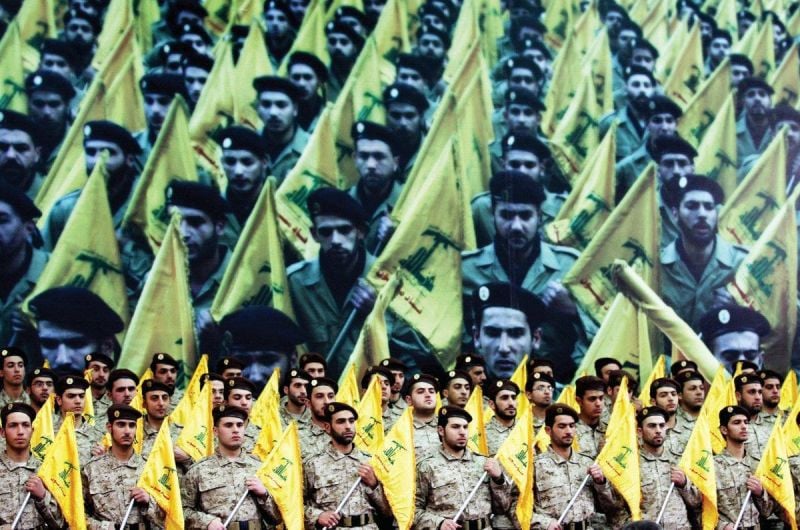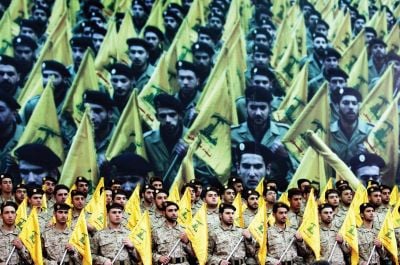
Hezbollah fighters in the southern suburbs of Beirut. (Credit: Joseph Barrak/AFP)
Part I: The early days of the “resistance.” Read Part II here.
How did a handful of men trained, indoctrinated and funded by Iran’s Islamic Revolutionary Guard Corps become, decades later, the pillars of Lebanon’s most powerful political and military organizations?
How did a party that was created on the fringes of society and saw itself as a parastate manage to gradually infiltrate the state until it became the system’s main political patron?
Hezbollah’s history with the Lebanese state is made up of tensions, ruptures, opportunistic alliances, the internal reshuffling of cards, tactical constraints and strategic choices linked to the ambitions of the Islamic Republic of Iran.
This history can be divided into two parts: the era of the “resistance,” from 1985 to 2000, and that of politics, which continues to this day.
Throughout the decades, Hezbollah has played on its multiple identities in a bid to continuously redefine its ties with the rest of Lebanon. The party has alternately, and sometimes simultaneously, been the voice of the downtrodden and oppressed, an armed wing of Iran, the embodiment of resistance against Israel and the instrument for Shiite revenge.
It all began when a group of men was tasked with exporting the Iranian revolution to Lebanon at the request of Ayatollah Ruhollah Khomeini.
In 1979, Iran’s supreme leader sent one of his aides, Sayyed Issa Tabatabai, to speed up the birth of what would be called Hezbollah a few years later.
The soil was fertile: The Lebanese Shiite community had been marginalized for centuries and for several years had been suffering under Israeli bombing of the Palestinians based in southern Lebanon.
The opportunity was all the more favorable as the community’s charismatic leader, Imam Moussa Sadr, who founded Harakat al-Mahrumin, or the “Movement of the Deprived,” had gone missing during a trip to Libya in 1978.
The 1982 Israeli invasion gave the IRGC the perfect pretext to buff up its recruitment and training, enabling what would become Hezbollah to swiftly rise to power under the guise of resistance to the enemy.
Officially, Hezbollah was founded in 1985. At first it defined itself as a jihadist resistance party with no political project in the country. Its aim was to fight against Israel and those who supported the Israeli occupation, as stated in the party’s manifesto, released in 1985.
At that time, Hezbollah operated according to the belief that the Lebanese regime, led by then-President Amin Gemayel, maintained ties with Israel. On May 17, 1983, Gemayel signed a deal with Israel under American auspices — an agreement the president was forced to rescind in March 1984 under pressure from Syria and its allies in Lebanon.
Khomeini designated the Lebanese government an infidel regime that must be confronted — which was noted in Hezbollah’s charter.
In the charter, Hezbollah also highlighted its faith in the velayat-e faqih — or “guardianship of the Islamic jurist” — advocating for the establishment of an Islamic state. The party, however, stated that this model could not be imposed in an environment that was not in favor of it.
The first legislative elections
The first real division among the party’s leaders came at the end of the 1980s, as a fratricidal Shiite war between the Amal Movement and Hezbollah was raging and the Lebanese Civil War, as a whole, was drawing to an end.
The charismatic Mohammad Hussein Fadlallah — an extremely influential alim, or “scholar,” in Shiite Islam, who is considered the pro-Iran party’s mentor, although he would later distance himself from it — and his partisans saw that Hezbollah could no longer boycott the state. They believed that at some moment the state would be restored, which was something the party needed to account for.
Fadlallah also called for establishing ties with other Arab countries and Western states, although the majority of Hezbollah’s members were against this view.
The 1989 Taif Agreement, which ended the Civil War, summed up all the ambiguity in the Shiite party’s relationship with the Lebanese state at the time: The party should have a say in all matters but without being a stakeholder in Lebanese institutions.
Hezbollah rejected the agreement, which redistributed powers among Lebanese political leaders, and accused it of inhibiting the state’s development. The party was, however, unable to offer an alternative and was left with two options: Join it or challenge it.
The Shiite party ended up opting for the first choice, but not without laying its own conditions. Hezbollah refused to dismantle its militia or hand over its arms to the state, and continued to uphold the right of resistance.
At the time, the party continued to view the state as more an enemy than a potential instrument to serve its interests.
But in the late 1980s and early ’90s, the regional context began to shift. The Iran–Iraq war came to an end, a truce was struck between Riyadh and Tehran and relations between Iran and Syria strengthened — all of which opened up new possibilities on the Lebanese scene.
After years of bloody conflict, Hezbollah and Amal buried the hatchet under the sponsorship of Tehran and Damascus.
Their tasks were divided: Hezbollah would uphold the resistance, and Amal would maintain Shiite representation within the state.
During this period, the Party of God made one of the most significant decisions in its history: to run in the 1992 parliamentary elections — a ludicrous decision for a party that claimed not to recognize the legitimacy of the state it would represent.
In 1991, Ibrahim Amin al-Sayyed, one of Hezbollah’s leaders, had circulated a document internally that advocated for participation in the elections. This triggered a heated debate within the party, but no decision was made at the time.
A few months later, the debate was back on. Most of the party members approved of participating in the elections, with the exception of a minority group led by the party’s first secretary-general, Sheikh Subhi al-Tufayli.
As with every strategic issue within the party, Iran’s supreme leader had the final say. Ali Khamenei sanctioned Hezbollah’s entry into Lebanese politics but restricted its participation to Parliament.
Why? The objective was twofold: to protect the resistance and allow the party to cater to its supporters’ needs.
Choosing the system over the revolution
Abbas al-Musawi, who was appointed Hezbollah’s secretary-general in May 1991, was assassinated in an Israeli raid in February 1992, a few months before the elections.
This, however, did not deter the party from making a sensational entry into Parliament by securing 12 seats, to everyone’s surprise.
Hassan Nasrallah was elected to replace Musawi as the party’s head, and those who opposed his election, including Tufayli, would gradually become marginalized within the party.
Tufayli had entered Lebanese political life at a time when diplomacy was back on track throughout the region. The Oslo negotiations were in the making, prompting hopes for peace in the Middle East among several of the region’s leaders, including Lebanon’s Sunni then–prime minister, Rafik Hariri.
But Hezbollah and its Iranian patron saw things differently.
In 1993, the party held a protest against peace with Israel and clashed with the Lebanese Army. Nine people died. Some party members called for a full-on confrontation with the army, but a decision was made to calm the situation.
At the same time, Hezbollah stepped up its military operations against Israel in the south and rejected the Lebanese Army’s deployment in the area.
Tensions were running high, and the situation exploded when Israel launched Operation Grapes of Wrath on southern Lebanon in April 1996. When the war ended, Hezbollah emerged stronger on the political scene, having been recognized as a strong force by the international community.
The Shiite party felt more confident and more powerful, as if it had a more legitimate claim to what it considered its rightful place on the national scene.
This newfound confidence, however, posed a threat to the position of Hezbollah’s ally the Amal Movement, which was still the master of the game on the ground and was backed by Syria, which still had troops present in the country.
Hezbollah chose to ally with the leftist forces in the elections against Amal and the Syrians, campaigning against Parliament Speaker Nabih Berri’s party, which was often viewed as functioning as a top-down patronage network.
Berri began to seriously worry. While Hezbollah could not yet threaten him in Beirut, it could inflict serious political damage on Amal’s strongholds in the south and the Bekaa.
The speaker headed to Syria for a tête-à-tête with then–Syrian President Hafez al-Assad.
“If Hezbollah joins hands with the leftist forces, Amal will suffer a crushing defeat,” Berri warned, asking his ally to intervene.
The Syrian president relayed the message to his contacts in Iran and asked his powerful head of intelligence, Ghazi Kanaan, to settle the matter in Lebanon.
What followed was a meeting organized between Kanaan and Nasrallah in Anjar.
The Syrian regime could not be any clearer: Hezbollah must break its alliance with the leftist forces or bear the consequences of undermining its own security and stability.
The Shiite party did not want bloodshed, and its leader decided to shift alliances at the last moment and join forces with Amal, without having the chance to inform Hezbollah’s Shura Council. The council members learned about the decision from the newspapers the next morning, which the Syrians were quick to leak to the media.
The news raised the ire of the party members.
Hezbollah chose the system over revolution, alliance over rebellion, the Iranian–Syrian axis over Lebanon — a choice that nothing would shake, even the Oct. 17, 2019, uprising.
Party unity
The year 1996 marked another turning point in Hezbollah’s history. Without recognizing Hariri as a political partner, Hezbollah nevertheless improved its relations with the prime minister, who played a pivotal role in the cease-fire negotiations with Israel in April of the same year.
From the Shiite party’s standpoint, Hariri remained the West’s ally and the sponsor of a patronage network that is very much despised by the party’s supporters.
Tufayli, who was a staunch supporter of an alliance with the left against Amal and Hariri, did not mince his words vis-à-vis these new developments.
In 1997, he began organizing rallies known as the “revolt of the hungry” that were intended to weaken Hariri, but his project was nipped in the bud by Hezbollah’s leaders.
Tufayli was expelled from Hezbollah in 1997, without having succeeded in creating rifts within the party.
During these decisive years, Hezbollah’s ranks were threatened by a split between the party’s left and right wings, but Nasrallah’s charismatic leadership and his privileged relations with the strongman on the ground, Imad Moghniye, helped preserve the party’s unity.
Hezbollah’s leadership was also able to rely on the powerful IRGC, despite the reformers’ victory in Iran.
Up until this point, the party was part of the country’s political landscape, but it had not integrated fully into Lebanese politics, let alone tilted them to its advantage.
The resistance remained at the core of its project. However, the Israeli withdrawal from the south in May 2000 was a game changer.
Without giving up its status as the defender of the resistance, which was still a legitimate pretext with the ongoing Israeli occupation of the Shebaa farms, Hezbollah was now able to concentrate on another project: a slow takeover over the Lebanese state.
This was made possible by a complex system of alliances and the withdrawal of the Syrian troops from Lebanon in 2005.
This article was originally published in French in L’Orient-Le Jour. Translation by Sahar Ghoussoub.
